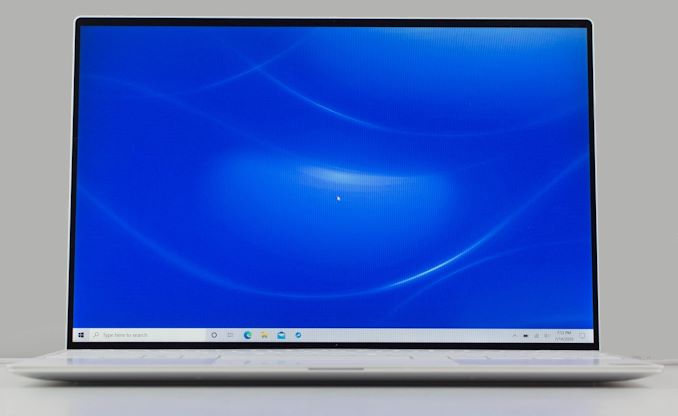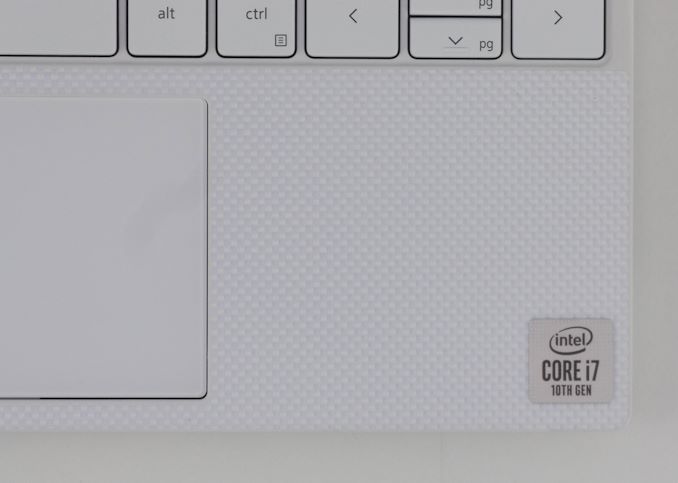The Dell XPS 13 (9300) Review: Return of the King
by Brett Howse on July 16, 2020 10:00 AM EST
Dell changed the Windows laptop market in a single stroke with the launch of the updated XPS 13 back in 2015, ushering in the world of the InfinityEdge display, and moving the entire industry forward. We were fortunate enough to get a chance to check out the precursor to the new XPS 13 back in November, with a review of the XPS 13 2-in-1. Dell had chosen not to rest on their laurels, and the 2-in-1 proved to be one of the best notebooks around if you needed a compact and powerful convertible laptop. Today we are evaluating the traditional clamshell version of the XPS 13, and while it offers many of the same features and design touches, it does so in a more familiar form factor that many customers are going to prefer.
For the 2020 refresh, Dell has made the refreshing move to taller displays, as we saw with the XPS 13 2-in-1. As a result the XPS 13 uses 13.4-inch display panel with a 16:10 aspect ratio, offering more vertical space for getting work done, and some convenient padding to place controls when watching 16:9 content. The larger display fits into a chassis that is actually 2% smaller than the outgoing design, with the new XPS 13 offering a 91.5% screen to body ratio.
This is actually the second time that Dell has refreshed the XPS 13 within the last year. The company previously updated the XPS 13 in August 2019 to use Intel's 10th generation Core processors, but presumably due to limited supply of Intel’s then-new Ice Lake platform, Dell opted to launch that iteration with Comet Lake-U processors. And under more normal circumstances we would have expected Dell to stick with an annual cadence – and thus Comet Lake – for an entire year. Instead, to some surprise, Dell gave the XPS 13 a further mid-generation refresh, launching the Ice Lake-based XPS 13 9300 model that we are reviewing today, and bringing the clamshell XPS 13 to parity with the 2-in-1 version.
The switch from Comet Lake to Ice Lake, in turn, is a significant one. it means the XPS 13 gets Intel’s new Sunny Cove CPU architecture, as well as the much-improved Gen 11 graphics. Dell offers Core i3, i5, and i7 models, with the Core i3 and i5 offering G1 graphics, meaning 32 Execution Units (EUs), and the top-tier Core i7-1065G7 featuring the full 64 EUs on the GPU side. Just as a comparison, the Comet Lake-U only offered 24 EUs of Gen 9.5 graphics, so even the base Ice Lake models still offer a 33% larger (and much newer) GPU than the outgoing models.
The move to Ice Lake also brings some badly-needed LPDDR4X support, which in turn means a 32 GB maximum memory option in the XPS 13 9300, up from 16 GB previously. Although Dell still lists a paltry 4 GB option on their specifications sheet, a quick look at the Dell.com site shows that, at least in the USA, it appears that 8 GB is the new minimum, and that is a welcome change. Offering just 4 GB of RAM in a premium Ultrabook was always a poor choice, even if it did allow Dell to hit a slightly lower price bracket. On the storage front there is more good news, with 256 GB the new minimum, with up to 2 TB available, and all drives are PCIe x4 NVMe offerings.
| Specifications of the Dell XPS 13 9300-Series | |||
| General Specifications As Tested: Core i7-1065G7 / 16GB / 512GB / 1920x1200 |
|||
| LCD | Diagonal | 13.4-inch | |
| Resolution | 1920×1200 | 3840×2400 | |
| Brightness | 500 cd/m² | 500 cd/m² | |
| Contrast Ratio | 1800:1 | 1500:1 | |
| Color Gamut | 100% sRGB | 100% sRGB 90% P3 |
|
| Features | Dolby Vision | Dolby Vision | |
| Touch Support | with or without touch | Yes | |
| Protective Glass | Corning Gorilla Glass 6 in case of touch-enabled model | ||
| CPU | Intel Core i3 1005G1 (4MB cache, up to 3.4GHz) Intel Quad Core i5 1035G1 (6MB cache, up to 3.6GHz) Intel Quad Core i7 1065G7 (8MB cache, up to 3.9GHz) |
||
| Graphics | Intel UHD Graphics Intel Iris Plus Graphics |
||
| RAM | 4 - 32 GB LPDDR4X-3733 DRAM (soldered/onboard) | ||
| Storage | 256 GB PCIe 3.0 x4 SSD 512 GB PCIe 3.0 x4 SSD 1 TB PCIe 3.0 x4 SSD 2 TB PCIe 3.0 x4 SSD |
||
| Wireless | Killer AX1650 Wi-Fi 6 + Bluetooth 5.0 (based on Intel's silicon) Killer AX500 Wi-Fi 6 + Bluetooth 5.0 (based on Qualcomm's silicon) |
||
| USB | 3.1 | 2 × TB 3/USB Gen 3.1 Gen 2 Type-C | |
| 3.0 | - | ||
| Thunderbolt | 2 × TB 3 (for data, charging, DP displays) | ||
| Cameras | Front | 720p HD webcam | |
| Other I/O | Microphone, 2 stereo speakers, audio jack | ||
| Battery | 52 Wh | 45 W AC Adapter (USB Type-C) | ||
| Dimensions | Width | 295.7 mm | 11.64 inches | |
| Depth | 198.7 mm | 7.82 inches | ||
| Thickness | 14.8 mm | 0.58 inches | ||
| Weight | non-touch 1.2 kilograms | 2.64 pounds touch-enabled 1.27 kilograms | 2.8 pounds |
||
| Launch Price | Starting at $999.99 | ||
Dell has gone all-in on USB-C with the new XPS 13, with one port on each side of the notebook. Both feature Thunderbolt 3 with 4 lanes, as well as power delivery for charging. The lack of a Type-A port may inconvenience some, but Dell does include an adapter in the box to assist. Wireless is the Killer AX1650, which based on the latest Intel AX200 wireless adapter – and with Intel purchasing Killer this partnership seems like it is not going anywhere.
If you read our review of the 2-in-1 version of this laptop, you will undoubtedly notice a lot of similarities. As they are from the same product line, that is not an accident: Dell has now refreshed their entire XPS series of laptops with a similar design philosophy. Let’s take a peek at what is new.











224 Comments
View All Comments
edved - Saturday, July 18, 2020 - link
I rec'd this Dell i7 with 16GB yesterday on the 16th and saw this review! Excellent write-up. Thanks for putting in the time & effort. Certainly reassures my purchase. It replaced a 5 yr old XPS 13.Pixelpusher6 - Sunday, July 19, 2020 - link
I've currently started looking for a new laptop. I'm leaning towards the Ryzen mobiles. One thing I've noticed though is the disappointing RAM options. For my use I need a minimum of 16GB. Using Win10 at work I'm averaging around 12-15GBs of usage, at home it is usually less around 7-10GB unless gaming. I don't understand why OEMs feel the need to solder RAM - do SODIMM slots really take up more space? The laptop I'm replacing is an older laptop that has a 24GB cache ssd soldered on which is failing, (in addition to a 512GB 860evo) and as a result Windows install hangs up, so I can only run Ubuntu. I love this laptop but I need to run Windows. What if you have soldered RAM and it fails outside of warranty?ajp_anton - Sunday, July 19, 2020 - link
I've had this laptop for 5 months and actually have lots of problems with it that Dell just refuses to fix. Their answer to all of the following is that it's "by design".- Custom charging. If you set the charging to stop at, say, 80% or 90% (to prolong the life of the battery), reach the desired level (so that it stops charging), and then stress the CPU, the charging will continuously start and stop at a 1-5 second interval. Because of this, the charging light at the front of the laptop will keep turning on and off, which is very annoying in a dark room.
- Every time the battery starts charging, the screen's backlight will flicker for one second, like there's some instability with switching from battery power to AC. This combined with the issue above makes the custom charging level pretty useless.
- When Panel Self Refresh is turn on (in Intel's settings), the screen will randomly insert black frames once or every 10mins to 10 hours. It's very random. Solution is to just turn off PSR.
- The fans will run when nothing in the laptop is above 60 degrees C. Once they turn on, they will keep spinning for a while even if everything cools down to under 50 degrees C. My experience with the laptop is that the fans just keep running almost all the time when just browsing the web. My cooling setting is set to "quiet".
- Mayor problems with sleep mode. The laptop occasionally wakes up and just loads up the CPU and overheats everything to 100 degrees C when inside my backpack. I've had to hack Windows to re-enable S3 sleep (instead of modern sleep). Since Dell can't handle "Modern standby" correctly, they could at least have a BIOS option to disable to altogether (in fact they have an option to disable S3), so the user wouldn't have to hack-enable it with Windows.
- Home and End button placement is horrible. I've asked to enable Fn+left and Fn+right in a BIOS update, as they used to be in older XPS laptops, and the technician thought it was a good idea, but there's nothing he could do because people higher-up didn't want this.
ajp_anton - Sunday, July 19, 2020 - link
Though in spite of all of these problems, I still like this laptop, and I don't know of a better one. The 16:10 screen alone makes this an obvious choice, and I just have to learn to live with (and work around) all the other issues.nfriedly - Sunday, July 19, 2020 - link
I love the idea controlling charging in software to extend the longevity of the battery!I'm not sure how you could feasibly report this, but I'd like to know how much difference it makes after a few years of use. Does Dell make any claims?
ajp_anton - Sunday, July 19, 2020 - link
There are problems with this particular laptop's custom charging. Read my comment above yours, the first two points.I've used this feature in an older XPS laptop (max charge at 80% except for long flights and such), the Skylake version, which is ~4 years old. It's been in pretty much constant use on-the-go, and battery wear is at 1%.
vermaden - Monday, July 20, 2020 - link
Just get Chuwi Aerobook 13 instead.Bigger and better keyboard (along with more keys) and also TWO USB A 3.x ports and USB C port.
... and it costs about $450 new.
This Dell XPS 13 looks lame to say the least with these only two USB-C ports ...
ajp_anton - Monday, July 20, 2020 - link
Um, what?A Skylake-Y CPU with max turbo at 2.2GHz? That's your alternative to a 4-core Ice Lake? And possibly the slowest iGPU in existence, compared to one of the fastest. 1920x1080 screen. The speakers are "bad, even by laptop standards". And despite the extremely slow and low-power CPU, battery life is also bad.
Yeah, totally comparable.
velanapontinha - Monday, July 20, 2020 - link
If only this was bases on a Ryzen 4700u...Smell This - Monday, July 20, 2020 - link
Well ... Duh!
;- )
Down With The King, Dell